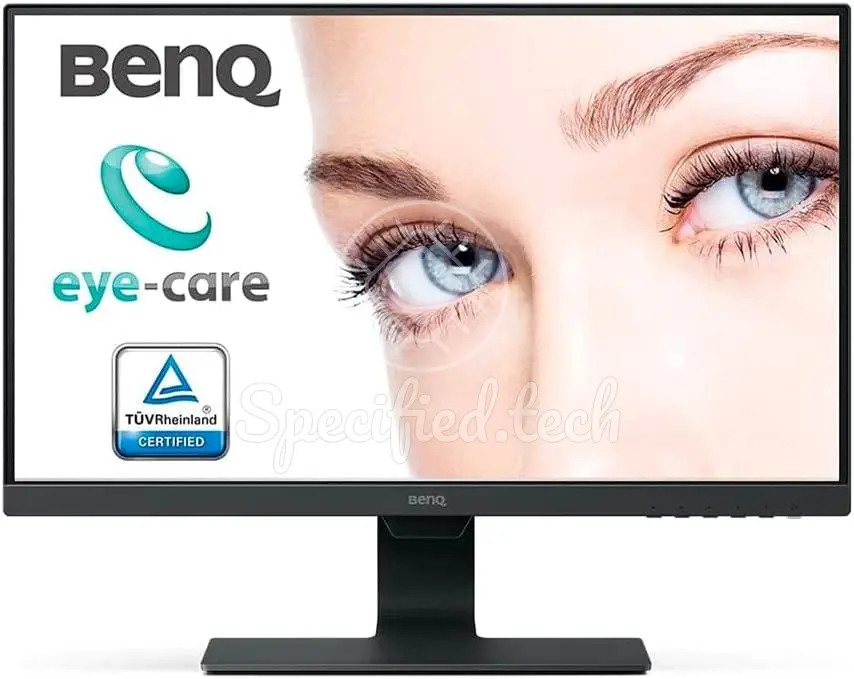
Today we will look at the monitor GL2480 from BenQ from the year 2019. Within this article, we will first take a closer look at the most important feature of a monitor -the display-, then the design, and in the next section we will go into the features of the monitor. Of course, power consumption, certifications, connectivity and other important details will also be considered.
Display
The display is sized at 24 inches ( 60.9 cm on the diagonal). For books or documents, a portrait format layout is usually used because the reading flow decreases as the width of the text increases. For small diagonals, screens in 4:3 format have a clear advantage because they are better suited for display due to their height. In contrast, widescreen monitors are better suited for playing video games or displaying several documents side by side, for example. Depending on the application, it should be decided individually whether the aspect ratio of 1.778 : 1 is sufficient. The display is a TN panel. The panel has a resolution of 1920 x 1080 px. The pixel density is 91 ppi. The pixel pitch is 0.277 mm. The continuous possible brightness specified by the manufacturer BenQ is 250 nt. The panel is illuminated by W-LED. The built-in panel ensures stable color reproduction of the image, even at deviating viewing angles, by means of its 170 ° (horizontal) viewing angle. BenQ promises stable color reproduction moreover within a 160 ° vertical angle. Vertically, however, the image renews at a minimum rate of 75 hz up to 75 hz. The minimum response time of the monitor is ms. The display panel is Anti-glare/Matte. With the 'Adaptive Brightness' feature of the GL2480 monitor, the screen brightness is intelligently adjusted to the lighting conditions of the scene. This feature helps to ensure that content is always optimally legible, regardless of whether the currently displayed scene is brightly or darkly lit.
Color representation
The panel has a bit depth of 8 per color channel, but what does that mean? The number of bits determines how many colors can be encoded for the individual pixels of the display. For an 8-bit panel, for example, this is 256 different colors (2^8 = 256). However, since we usually display three different colors per pixel at the same time, in theory about 16 million (256^3) different colors are possible by mixing the three pixels. A 10-bit panel could even display a billion colors. According to the manufacturer, the coverage of the NTSC 1953 color space is 72 %.
Contrast ratio
Contrast ratio is a common measurement used to represent the maximum relative differences in brightness between black and white. It describes the ability of a screen or projector to produce a high-contrast image and is the quotient of the maximum and minimum displayable luminance. The higher the values are away from each other, the stronger the quantitatively seen difference between black and white is set up, which in turn results in an improved image quality. This monitor from BenQ has a static contrast ratio of 1000 : 1 , according to the manufacturer. In contrast to the static contrast ratio, the dynamic contrast ratio changes the brightness of the panel itself in addition to the difference measurement from black to white. In addition to the difference between the brightest and the darkest pixel, the backlight is thus changed. Since the brightness of the panel may not be able to be adjusted exactly to a single pixel, a so-called halo effect is possible. The value of 12000000 : 1 of dynamic contrast ratio for the monitor GL2480 cannot provide any information about the severity of the halo effect here. Therefore, it is more useful to compare the static contrast ratio.
HDR
The monitor supports all HDR modes listed here:
screen design
If you want to place the monitor described here on the desk without a wall mount, you should allow for 43.3 x 56.5 x 17.5 cm (HxWxD) of space. If you want to place the monitor on a table or even transport it, you should expect a weight of 3.9 kg with the stand screwed in.
Rotate, tilt and swivel
The monitor from BenQ cannot be rotated. The monitor cannot be swiveled. This feature could be retrofitted with a third-party stand. Thanks to the tilt function of the GL2480 monitor, the screen position can be flexibly adjusted to minimize dazzling light sources and ensure optimum visibility. The angle of inclination to the rear is 20. The monitor can be tilted forward by 5 degree.
Ports
The monitor can be connected via 1 VGA ports.
camera
This monitor does not have a camera.
Features
- Flicker Free: BenQ 's Flicker Free technology minimizes distracting screen flicker, allowing you to work and/or play longer without restrictions.
Anyone who works a lot on the computer spends many hours a day in front of the screen. Excessive screen work can damage the eyes. This effect can be particularly pronounced during the darker hours and in the winter months. Many monitor manufacturers have now reacted and offer technologies and settings to reduce the blue component, which is primarily controversial. Depending on the manufacturer, these can be called "Low Blue Light", "Low Blue Light Technology", "SoftBlue" or even "Eye Saver Mode" and function differently. However, it is only important that BenQ offers a technology to reduce the blue content in its monitor GL2480.
Power consumption
On average, the monitor consumes approximately 25 w. In standby mode, the device consumes approximately 0.5 w. When switched off, on the other hand, the monitor consumes only 0.5 w. In ECO mode, the monitor consumes 17.48 w. The monitor can be operated on a 110v power supply. The monitor can be operated on a 220v power supply. The power grid has to supply a frequency of 50 hz to 60 hz.
Packaging
The box together with the monitor weighs about 7.3 kg.
Further information
- 100x100

